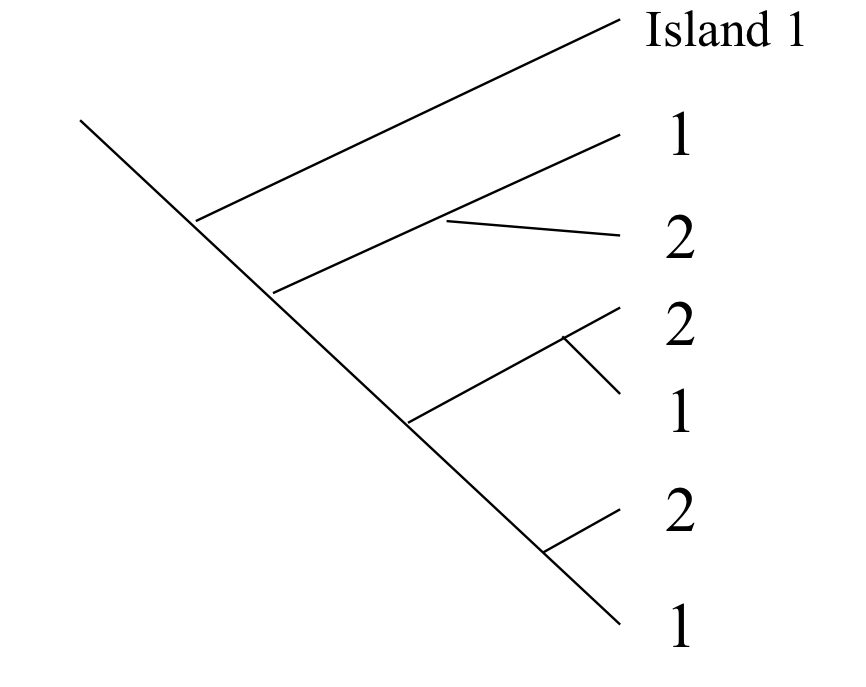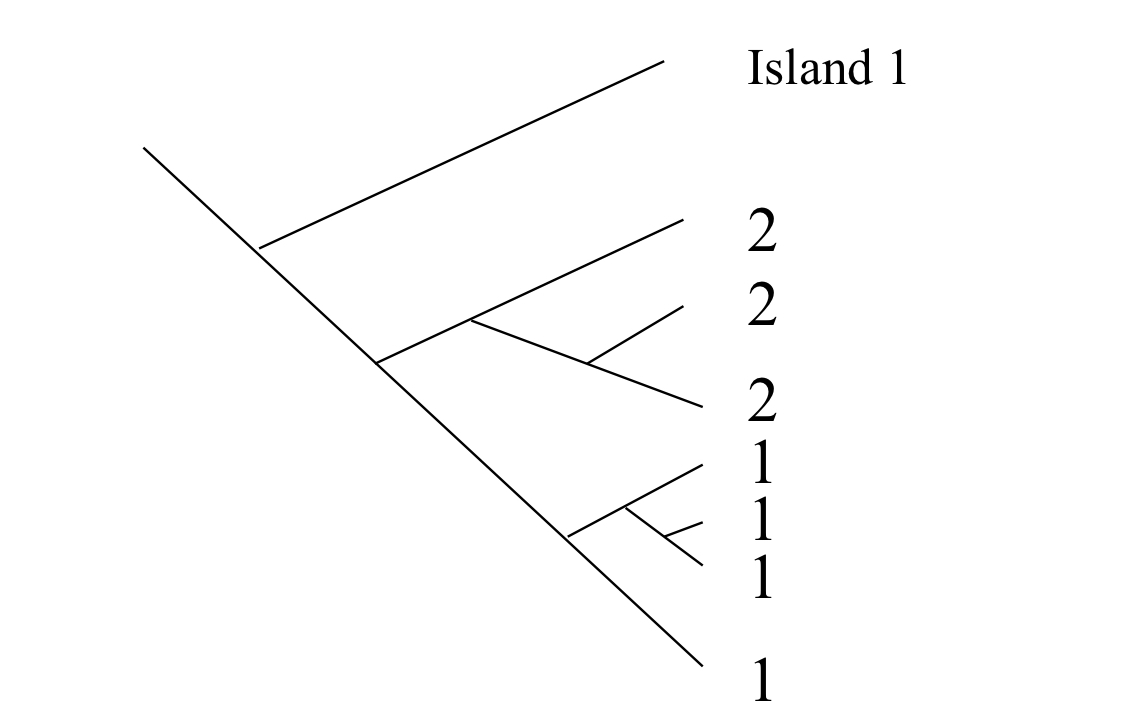Biodiversity and Speciation
1/23
There's no tags or description
Looks like no tags are added yet.
Name | Mastery | Learn | Test | Matching | Spaced |
|---|
No study sessions yet.
24 Terms
How do we map the genes responsible for species differences?
You conduct a Mendelian cross of two homozygotes to get a heterozygotic F1 generation, then you cross F1 x F2 to get F2 generation that contains a full range of parental phenotypes
Under what conditions would two populations become the most genetically distinct?
When gene flow between the two populations is rare/nonexistent; even if selection is strong, or there is a high mutation rate, or new beneficial alleles are arising, if gene flow is occurring between two populations, they are not going to become as genetically distinct as if gene flow is not occurring between them
What causes divergence between species?
Mutation → a little bit, but it is very slow
Drift → yes, especially when populations are small
Inbreeding → yes for genotypes, but only when coupled with drift or selection
Selection → yes, especially if environment differs between two populations
Migration (gene flow) → NO; this causes convergence, not divergence
isolation by itself is not enough to differentiate, other factors like drift or selection must be acting to cause populations to diverge
What are the barriers to gene flow called?
Reproductive isolating mechanisms; there are two main groups: prezygotic isolation and postzygotic isolation
What is prezygotic isolation and what are some mechanisms it occurs by?
This kind of reproductive isolation occurs before the hybrid zygote is formed
Geographic Isolation → differences in space; individuals do not overlap in environments
Temporal Isolation → differences in time; individuals are not reproductively active at the same time/season
Behavioral Isolation → sexes of the two populations are not attracted
Mechanical Isolation → the parts (genitalia) don’t fit; ex. chirality of snails
Gametic Isolation → copulation occurs, but does not produce a zygote because gametes are incompatible due to chemical imbalances or environment of mother
What is postzygotic isolation and what are some mechanisms?
It occurs after individuals have invested in courtship and mating
Hybrid Inviability → hybrid zygotes are formed but are inviable or have extremely reduced fitness
Hybrid Sterility → hybrids of one sex or the other do not produce functional gametes
Bateson-Dohazhansky-Muller incompatibility → epistasis; pollen is sterile unless BOTH male sterility loci have alleles from the same parent type
What is the General model of speciation (Bateson-Dobzhansky-Muller model)?
Two subpopulations become isolated
A new variant arises through mutation
New variants become fixed through selection or drift
Reproductive isolation occurs between populations that come into secondary contact
What is allopatric speciation?
This kind of speciation relies on physical isolation and was originally the only accepted mechanism of speciation; geographic isolation occurs between populations, eliminating gene flow; this allows divergence through drift, selection, and other mechanisms; divergence occurs gradually and can involve many genes
Some types are:
Vicariance
Dispersal
Distance
What is vicariance?
When a species range is divided by a geographic barrier; this predicts that closely related “sister” species pairs should exist on opposite sides of the barrier; ex. snapping shrimp on opposite sides of the Panama isthmus are more closely related to each other than species on the same side are
Does vicariance happen at the same rate for all species being separated?
No, in the snapping shrimp example, deep water species separated earliest and shallow water species separated most recently
What is dispersal?
When individuals colonize new areas from an existing population; this predicts that sister species will exist in the same region, and dispersal pattern should reflect geological history; ex. swordtail crickets show phylogenetic signal of speciation through dispersal on the Hawaiian islands (branches originate from the next oldest species/island)
How does so much speciation occur on one island in the cricket dispersal example?
Multiple Invasions → invasion occurs multiple different times over a long time period; the first invasion is geographically isolated from the parent population, allowing it to diverge, so when the second invasion occurs, the two populations are different, allowing them to differentiate into two different species
In situ (sympatric) speciation → all species on an island descend from a common ancestor and diversify on the new island; would all come from a single branch on a phylogeny

What scenario of speciation on islands does this phylogeny represent?
Multiple Invasions → multiple branches going from Island 1 to Island 2

What scenario of speciation on islands does this phylogeny represent?
In situ specitation → one branch going from Island 1 to Island 2 (reflects singular common ancestor)
What is Isolation by Distance?
This occurs due to physical distance between species without a physical barrier; contiguous populations that span a wide geographic range are unlikely to exchange genes between opposite ends of the range, meaning the extremes of the range are isolated from each other, but neither extreme is isolated from the middle of the range
What are ring species?
This is a special case of isolation by distance where the ends of the range wrap around a physical barrier like a mountain or a desert and the two edges of the range come into contact; the members of the species at either end of the range cannot interbreed, but they are still considered the same species; ex. the Ensatina salamanders in California
What is Sympatric Speciation?
This is a form of speciation that relies on biological barriers to gene flow rather than physical barriers (like with allopatric speciation); isolation arises quickly within a population, meaning that it only affects a few genes, and there is typically strong selection against hybrids; there are many mechanisms that sympatric speciation can occur by: temporal, behavioral, mechanical, polyploidy
Some types are:
secondary reinforcement of isolation
hybrid speciation
ecological speciation
What are 3 outcomes of hybridization on speciation?
Secondary reinforcement of prezygotic isolation → hybrids are less fit, so selection favors individuals who are less likely to mate with other species
Maintenance of stable hybrid zones → hybrids are viable and can backcross, and usually are only viable in a restricted area where they persist
Formation of new species (hybrid speciation) → hybrids are viable and isolated from parent species; survive and become own lineage
How does secondary reinforcement of prezygotic isolation work?
selection favors mechanisms that prevent wasting gametes and energy that lead to hybrid formation
in allopatry, two diverging species may have similar characters, but when they come back into contact and are in sympatry, reinforcement is likely to favor character displacement (changing of one of the species characters to make hybridization less likely)
Which mechanism of isolation is secondary reinforcement most likely to result in?
Prezygotic mechanisms such as temporal isolation, gametic isolation, mechanical isolation, etc.
How does hybrid speciation work?
It is said to be homoploid speciation, so there is no change in ploidy; it requires that hybridization occurs and offspring are viable and fertile; this usually involves habitat differences between parent species and new niche for hybrid because hybridization can generate new gene combinations that dramatically increase variation for selection to work with; the important thing is that the new hybrid species are isolated from the parent species in some way
How do stable hybrid zones work?
Hybrid genotypes seem to be favored in a narrow band of contact between two parent species but they don’t spread outward because they are less fit away from the zone; these hybrid zones can depend on environmental variables and those variables may change, shifting the hybrid zones; species 1, species 2, and the hybrid can all do well in the hybrid zone, but the backcrosses between hybrid and species 1 or hybrid and species 2 do not survive well outside of the zone, keeping the genes from species 1 isolated from species 2
What is ecological speciation?
This is a form of sympatric speciation; environment based selection selects very strongly against hybrids, causing reproductive isolation; just getting bad gene combinations in a hybrid alone is not ecological speciation; getting bad gene combinations in a hybrid that causes it to perform poorly in its environment would be ecological speciation; can occur through pre or post zygotic mechanisms, but the key is that hybrid fitness is very low, so selection is very strong against hybrid production
What is adaptive radiation?
A rapid increase in the number of species in a short geological time period; this expansion of species fills diverse ecological niches; this can occur due to hybridization that creates new genetic variation, leading to rapid expansion of genetic and phenotypic diversity; in a phylogeny, this looks like branching off that is occurring early and roughly around the same time because the speciation is happening in a short time period to fill newly available niches; on small/medium islands, adaptive radiation shows species accumulation expanding rapidly than plateauing